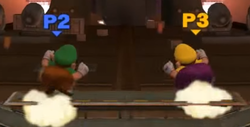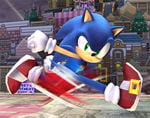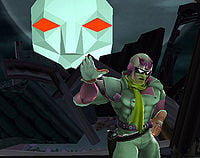Taunt match: Difference between revisions
mNo edit summary |
Tag: Mobile edit |
||
| Line 24: | Line 24: | ||
==In ''[[Super Smash Bros. Ultimate]]''== | ==In ''[[Super Smash Bros. Ultimate]]''== | ||
Taunt matches are | Taunt matches are not common in ''Ultimate''. As taunts are banned in [[Quickplay]], and due to the nature of the matchmaking system, most players will not engage in true taunt matches. When taunt matches do occur, pseudo-taunting by repeatedly crouching (teabagging) is an extremely common substitute for true taunt matches, and the addition of [[Battle Arena]]s allows players to indulge in taunt matches (with unlimited access to all taunts) without disrupting serious play by creating dedicated arenas for taunt matches (typically labeled with the "Playground" descriptor). | ||
==Trivia== | ==Trivia== | ||
Revision as of 18:00, January 4, 2021
A taunt match or taunt party is a type of match where players refuse to take the actual battle seriously; instead, they focus on behavior that is aggravating or otherwise irritating to players who are interested in actually fighting, or they simply do not fight other players. Taunt matches can be seen as a form of griefing, owing to the fact that players who start taunt matches often team up on players who attempt to take the match seriously.
Taunt matches can theoretically be performed in any mode in any of the games. In an EVO 2015 qualifier match, for instance, smashers Manny and True Blue performed a partial taunt match where they both charged Sonic's Spin Dash for over a minute. Taunt matches, however, have been primarily associated with online play, especially in Brawl, and they later became a large point of criticism for Brawl's online modes.
Overview
Exact behavior in taunt matches varies from match to match, but the overall concept of generally not fighting others remains the same. Contrary to their name, taunt matches do not have to specifically feature excessive or non-stop taunting from players; moves that produce repetitive, loud noises can also be used by players, such as Ganondorf's up smash, Kirby's crouch animation, Charizard's Rock Smash, or Shulk's Back Slash. As other forms of griefing, players can also abuse glitches, hack the game to display unusual stages (e.g. the Trophy Rush stage) or force desynchs, exacerbate the lag seen on Wi-Fi via abusing moves such as Transform, or otherwise act uselessly, such as by constantly backfiring Diddy Kong's Peanut Popgun, constantly breaking their shield, moving back and forth via crawling, walking or dashing, edge running, or even completely refraining from performing any actions. Costumes can also play a role in taunt matches, with players often choosing "flashy" and "flamboyant" costumes such as pink palette swaps (most infamously with Captain Falcon) and Shulk's shirtless costume. In Brawl, the stage of Temple is a common pick amongst taunt matches, as its large size allows players to easily avoid serious players, though the deadly stage hazards of New Pork City make that stage a relatively common pick as well.
A sense of cooperation is generally seen in taunt matches, with most of them involving a group of either two or three people all working together in the match. Very cooperative players may use the same character as to synchronize taunts or to otherwise assist in preventing serious matches from occurring. Etiquette is also often displayed by those who start taunt matches; accidental attacks are sometimes followed up with the offending player crouching as a form of apology.
An idea behind a taunt match is to get all players into the spirit of the match; despite this, serious players often attempt to "force" the taunt match to end, but the presence of multiple players can make this almost impossible. Players who wish to keep the taunt match going may either constantly run away from the serious player via the aid of large stages, crowd in the same area to create a near-impregnable camping tactic, or team up on the serious player; in this regard, the use of Mr. Game & Watch is popular with characters such as Samus or Ness, due to his Oil Panic move, though other strategies may involve forcing serious players into a Falcon Punch or other moves, or otherwise merely inflicting considerable damage and then getting an easy KO.
In Super Smash Bros. Brawl
The anonymity of Basic Brawl allowed for numerous taunt matches to occur. In addition to numerous other perceived flaws with the mode, the inability to otherwise avoid taunt matches via a reporting system or similar method caused Basic Brawl to garner considerable criticism from players.
In Super Smash Bros. 4

As one of multiple changes made for the game's new online mode, Smash 4 added a system as an attempt to combat players who attempt taunt matches or otherwise grief; among the offenses that players can be temporarily banned for include refraining from fighting, relentlessly targeting a specific player, intentionally self-destructing in a short period of time, and "other abuses of the system". Additionally, there is a limit to how often players can taunt during a match in With Anyone mode. Once the limit is reached, players are prevented from using taunts. The initial limit is 2, but scoring a KO allows a player to taunt again. This limit actually has a negative effect on certain characters such as Kirby, who is unable to discard a copy ability once the limit is reached.
Taunt matches are still a fairly common occurrence, particularly on For Fun. However, as a result of the taunting limit, they are not nearly as ubiquitous as they were in Brawl. As such, SSB4 taunt matches have not reached the same level of notoriety as they did in Brawl, especially because they can be largely avoided on For Glory.
As to circumvent the taunt limit in online play, players who take part in taunt matches instead often use characters such as Wario and Palutena with repetitive or aggravating attack animations and sounds, as their attacks can be used as pseudo-taunts that can bypass the taunt limit.
In Super Smash Bros. Ultimate
Taunt matches are not common in Ultimate. As taunts are banned in Quickplay, and due to the nature of the matchmaking system, most players will not engage in true taunt matches. When taunt matches do occur, pseudo-taunting by repeatedly crouching (teabagging) is an extremely common substitute for true taunt matches, and the addition of Battle Arenas allows players to indulge in taunt matches (with unlimited access to all taunts) without disrupting serious play by creating dedicated arenas for taunt matches (typically labeled with the "Playground" descriptor).
Trivia
- Super Smash Bros. Ultimate attempts to circumvent taunt matches entirely by not allowing taunts to be used online. Nonetheless, a commercial for the game shows two Warios using synchronized Wario Wafts and taunts in a manner that was popular in SSB4 taunt matches.

